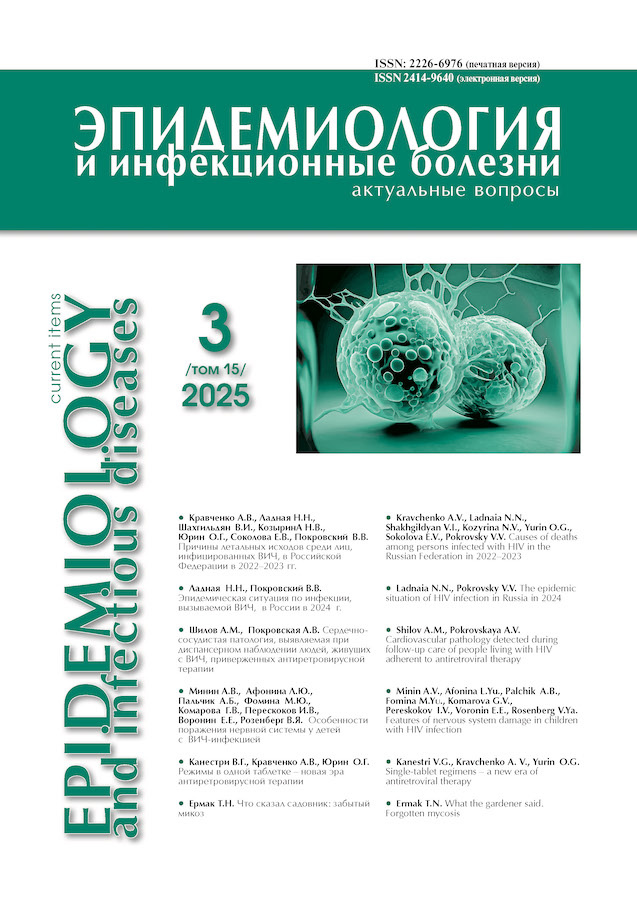Impact of late diagnosis of hiv infection on patient survival
- Authors: Agliullina S.T.1, Khasanova G.R.1,2, Appakova S.S.3
-
Affiliations:
- Kazan State Medical University,Ministry of Health of the Russia
- Republican Center for the Prevention and Control of AIDS and Infectious Diseases, Ministry of Health of the Republic of Tatarstan
- Center for Hygiene and Epidemiology in the Mari El Republic
- Issue: Vol 15, No 3 (2025)
- Pages: 69-74
- Section: Original Investigations
- URL: https://journals.eco-vector.com/2226-6976/article/view/691596
- DOI: https://doi.org/10.18565/epidem.2025.15.3.69-74
- ID: 691596
Cite item
Abstract
Objective. Assessment of the impact of late diagnosis of HIV infection on patient survival and factors associated with deaths from causes related to the progression of HIV infection.
Materials and methods. The data of 1072 patients over 18 years old who were diagnosed with HIV infection for the first time in 2019 were analyzed. Socio-demographic and clinical data of patients, as well as death data were collected and analyzed. The follow-up period was from the moment of detection to November 2023. The criteria for late diagnosis were a CD4 cell count below 200 cells/mm3 and/or HIV infection stage 4, established within 3 months after detection of HIV infection. Extensive indicators (proportions, %), adjusted odds ratios (AORs) and their 95% CIs were calculated.
Results. During the follow-up period, 235 (21.9%) people died, including 95 people from causes associated with the progression of HIV infection. Using Cox regression, it was found that the risk of death from causes associated with the progression of HIV infection was increased by factors such as late diagnosis (adjusted odds ratio (aOR) 8.424; 95% CI 4.805–14.768), living in rural areas (aOR 2.210; 95% CI 1.294–3.774), and age (AOR 1.041; 95% CI 1.019–1.063). However, this risk was reduced when patients used antiretroviral therapy (aOR 0.159; 95% CI 0.097–0.261). The risks of death decreased among workers by 2.123 times (aOR 0.471; 95% CI 0.283–0.783), among pensioners by 3.554 times (aOR 0.281; 95% CI 0.089–0.891), compared with the unemployed.
Conclusion. Late diagnosis of HIV infection increases the risk of death from HIV/AIDS-related causes. In this regard, it is important to maximally improve access to counseling and screening testing for HIV infection for all population groups.
Keywords
Full Text
About the authors
Saida T. Agliullina
Kazan State Medical University,Ministry of Health of the Russia
Author for correspondence.
Email: saida.agliullina@kazangmu.ru
ORCID iD: 0000-0003-4733-6911
Cand. Med. Sci., Associate Professor, Associate Professor, Department of Epidemiology and Evidence-Based Medicine
Russian Federation, KazanGulshat R. Khasanova
Kazan State Medical University,Ministry of Health of the Russia; Republican Center for the Prevention and Control of AIDS and Infectious Diseases, Ministry of Health of the Republic of Tatarstan
Email: gulshatra@mail.ru
ORCID iD: 0000-0002-1733-2576
Professor, MD, Head, Department of Epidemiology and Evidence-Based Medicine, IInfectiologist
Russian Federation, Kazan; KazanSabina S. Appakova
Center for Hygiene and Epidemiology in the Mari El Republic
Email: sabinasabinn@mail.ru
ORCID iD: 0009-0004-0643-435X
Medical Microbiologist
Russian Federation, Yoshkar-OlaReferences
- Покровский В.В., Ладная Н.Н. Вирус иммунодефицита человека в Российской Федерации в 2023 г. Эпидемиол. инфекц. болезни. Актуал. вопр. 2024; 14(3): 21−29. doi: 10.18565/epidem.2024.14.3.21-9. Pokrovsky V.V., Ladnaia N.N. [Human Immunodeficiency Virus in the Russian Federation in 2023]. Epidemiоlоgy and infectious diseases. Current items. 2024; 14(3): 21−29. (In Russ.). doi: 10.18565/epidem.2024.14.3.21-9
- Николаева Н.А., Ладная Н.Н., Помазкин Д.В., Коротких А.М., Санишвили Т.Т. Оценка социальноэкономических потерь общества от эпидемии ВИЧ/СПИДа в России. Эпидемиол. инфекц. болезни. Актуал. вопр. 2024; 14(3): 13–20. doi: 10.18565/epidem.2024.14.3.13-20. Nikolaeva N.A., Ladnaia N.N., Pomazkin D.V., Korotkikh A.M., Sanishvili T.T. [Assessment of social and economic impact of the HIV/AIDS epidemic in Russia]. Epidemiоlоgy and infectious diseases. Сurrent items 2024; 14(3): 13–20. (In Russ.). doi: 10.18565/epidem.2024.14.3.13-20
- Govender R.D., Hashim M.J., Khan M.A., Mustafa H., Khan G. Global Epidemiology of HIV/AIDS: A Resurgence in North America and Europe. J. Epidemiol. Glob. Health 2021; 11(3): 296–301. doi: 10.2991/jegh.k.210621.001
- Pu J.F., Wu J. Survival analysis of PLWHA undergoing combined antiretroviral therapy: exploring long-term prognosis and influencing factors. Front. Public Health 2024; 12: 1327264. doi: 10.3389/fpubh.2024.1327264
- Wang S., Tang H., Zhao D., Cai C., Jin Y., Qin Q. et al. Survival of People Living with HIV/AIDS from Pre-ART Era to Treat-all Era - China, 1985-2022. China CDC Wkly. 2024; 6(48): 1264–1270. doi: 10.46234/ccdcw2024.253
- Sobrino-Vegas P., Moreno S., Rubio R., Viciana P., Bernardino J.I., Blanco J.R. et al. Impact of late presentation of HIV infection on short-, mid- and long-term mortality and causes of death in a multicenter national cohort: 2004–2013. J. Infect. 2016; 72(5): 587–596. doi: 10.1016/j.jinf.2016.01.017
Supplementary files











